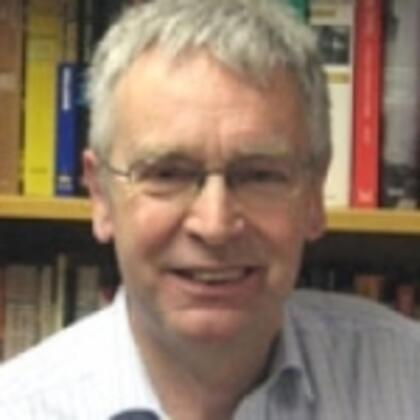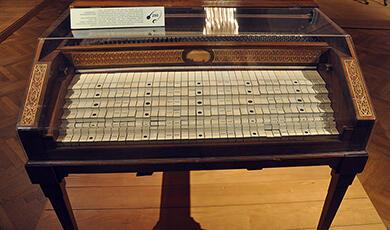Canzonas and Easter Masses
Share
- Details
- Transcript
- Audio
- Downloads
- Extra Reading
The High Renaissance and Early Baroque periods are regarded by Poles as among the most glorious in their country's cultural history. The range of instrumental and vocal music is astonishing. So what do works by Marcin Leopolita, Adam Jarz?bski or Marcin Mielczewski add to our understanding of European and Polish culture of the time?
Download Transcript
'Canzonas and Easter Masses'
Professor Adrian Thomas
Introduction
Good afternoon, and welcome to the fifth in this year's Music lectures at Gresham College. Last month, my topic was Polish music in the age of Copernicus, the period generally known in Poland as the 'Golden Age' (Złoty Wiek). Its flowering of Italianate architecture, Flemish tapestries and literature in the Polish language was matched in music by advances in theoretical thought, in keyboard music and unaccompanied choral music (such as the songs by Wacław of Szamotuły), in ceremonial music for royal occasions, in music for lute virtuosos and the simple, direct settings of the Psalms, translated by Jan Kochanowski and set by Mikołaj Gomółka in 1580.
Today, my topic is Polish music in the early Baroque period, that is from the very end of the 16th century up to the death of the composer Bartłomiej Pękiel in 1670. Generally speaking, the architecture, painting and literature of this period is highly Italianate in style. Musically, there is a significant shift in idiom, a new focus on sacred music, and changing political and geographical circumstances for the creation and propagation of Polish music.
Visiting Composers and the Italian Connection
The strength of influence of Italian music and musicians on Polish culture is one feature that straddles the 16th and 17th centuries. The musicians included both composers and instrumentalists (but not normally singers, who tended to be homegrown). Foreign musicians were employed primarily at the royal court and in the Chapel Royal, then some 50-strong and at a high-point in its long and distinguished history. These visitors included major composers such as Giovanni Frances co Anerio (c.1567-1630), who had formerly been the choirmaster of the Lateran Cathedral in Rome, and Marco Scacchi (c.1600 to after 1681), who worked at the Chapel Royal for over a quarter of a century (1623-49).
Among the Italian visitors to the late-Renaissance court of King Sigismund III Vasa, who reigned from 1587-1632, was Luca Marenzio (1553/4-99), who came to Kraków at the very end of his life (1596-98). Marenzio was one of the major madrigalists of his time as well as a composer of songs such as the villanelle Ard'ogn'hora il cor lasso. This is a love song, purely secular, flirtatious, dainty and dancing and a typical evocation of courtly ardour with its talk of fire and water. Its melody and accompaniment are diatonic and non-contrapuntal. It is performed here by a solo soprano, accompanied by a sopranino recorder, violin and bass viola da gamba.
MUSIC 1 Ard'ogn'hora il cor lasso (My weary heart ever burns)
Such secular ardour, so characteristic of madrigals at the end of the 16th century, continued in Italy in the works of Monteverdi and Gesualdo in the early 17th century. It was to be heard in the development of the Italian 16th-century intermedii, with their extravagant productions. And it also led to the idea of what we now know as opera, with its precedents in Greek myth and drama, with works such as Monteverdi's L'Orfeo (1607).
Interestingly, and perhaps unexpectedy, Italian opera found a foothold in Poland. Sigismund III's successor, Ladislas IV (1632-48), was a cultured patron who had a particular passion for music for the stage. He established opera performances in 1628 after returning from a trip to Italy a few years earlier. He had even met Monteverdi in Mantua in 1624 and tried unsuccessfully to lure him to Poland (although Monteverdi did dedicate some pieces to him). On his return to Poland, Ladislas set up what was probably the first court opera theatre north of the Alps. Unfortunately, nothing remains of the music of the essentially Italian productions that followed at the Warsaw court. Secular song, too, seems to have virtually disappeared from Polish musical life, so with Marenzio's ardent wooing of his lady we bid farewell to secular love and turn our face to our Maker in the predominantly sacred music of 17th-century Poland (with the odd instrumental canzona thrown in for light relief!).
Did I mention Warsaw, not Kraków, as the seat of the Royal Court a moment ago? I need to sketch a little of Poland's 17th-century historical turmoil.
Historical Background
By the 17th century, Poland was a Commonwealth with an elected monarchy. In 1596, Sigismund III had moved the capital and court from Kraków to Warsaw, where he built the Royal Castle. As the century progressed, Poland became embroiled in conflict, not least because Sigismund claimed the throne of Sweden. This prolonged conflict led to the Swedish invasion of Poland and the ransacking of Warsaw in 1655, when most artists fled the new capital, many returning to Kraków. Sigismund also recognised the pretender to the Russian throne, Dimitri (a figure later to appear in Mussorgsky's opera Boris Godounov), and this led to conflict with Russia too. And this is not to mention the ever-present threat of a religious war from Turkey.
Despite this lack of political and military stability, the arts flourished under the enthusiastic patronage particularly of Sigismund, Ladislas and their high-placed relatives. Literary figures, for instance, included Mikołaj Sęp-Szarzyński and Hieronym Morsztyn.
Musical Background
The strong ties with Italy had already developed to such an extent that one Polish composer, Franciszek Lilius (c.1600-57), could boast Italian origins (Lilius = Gigli). Sigismund III favoured music for voices, notably a cappella music, not least because he also sang. As the Papal Nuncio said of his successor: " "Ladislas greatly appreciates music, and though not himself a singer, as was the late king, he has a liking for singing and keeps many excellent voices. The father had far more chapel singers, the son has less, yet better and able of holding their own against the best in Europe." 1
The crucial feature of the early years of the 17th century was the divide between what became known as the stile antico and the stile moderno. The former was associated with the polyphonic sacred choral style epitomised by the music of Palestrina (who had died in 1594). While this label was not current until the 1640s (and Marco Scacchi in Warsaw was one of those who employed it), another pair of terms, roughly equivalent, was coined by Monteverdi. For him, antico was prima prattica andmoderno was seconda prattica. Monteverdi's second prattica was characterised by a more deliberately diatonic, chordal approach to music that enabled a direct expressive relationship with the vivid texts of madrigals, opera and also in sacred music. In this way, greater momentum, contrasts and drama could be obtained.
Mikołaj Zieleński
There is no clearer indication of the change in style in Polish music than the majestic Magnificat by Mikołaj Zieleński, published in Venice in March 1611 (exactly 395 years ago!). Listen out particularly for the rhythmic vitality in the setting of 'Et exaltavit spiritus meus' and the dynamic trading of 'in Deo'.
MUSIC 2 Mikołaj Zieleński Magnificat (opening)
Zieleński employs three choirs in the antiphonal style developed in St Mark's Basilica in Venice by Giovanni Gabrieli. You will have noticed that Zieleński doubles his voices with instruments, and each choir has a different complement to emphasise the polychoral contrasts (Choir 3 is noticeably lower in register than the other two, and Choir 2 has less instrumental backing). In this recording, the combinations are:
Choir 1 SSAT + cornett, violin, viola, viola da gamba, positive organ
Choir 2 SATB + positive organ
Choir 3 ATBB + four sackbutts, positive organ.
Zieleński's music is rhythmically and metrically alive, and when 'pointed' by these contrasting timbres it swings! As the Magnificat proceeds, the choirs become increasingly imitative and overlapping as they approach the final affirmative tutti.
MUSIC 3 Mikołaj Zieleński Magnificat (close, from 'Gloria')
Who was Mikołaj Zieleński? The only date we know for certain is that of the publication of 1611 from which the Magnificat is drawn. This was hisOffertoria et Communiones totius anni. There is, however, no evidence that he went to Venice himself. We do know that he was the organist and composer for Primate Wojciech Baranowski in Łowicz, to the west of Warsaw. Baranowski was a musician too: "When in Italy, he learnt to sing beautifully and not out of tune like the other clergy". 2 Zieleński'sOffertoria et Communiones was almost certainly sponsored by Baranowski and the composer's standing must have been considerable - or the bravado equally so - for these pieces to have been published in Venice at this time. It was, after all, just fourteen years after the publication there of Gabrieli's first book of Sacrae Symphonia (1597) and one year since the appearance of Monteverdi's Vespro della Beata Virgine(1610).
Zieleński's Offertoria et Communinones contains over a hundred pieces, from works for two or three choirs to psalms, antiphons and instrumental fantasies. He evidently thought highly of them, commenting in his preface that they had been "accomplished by a Pole in a new fashion". For once, Polish music was right up to date with its competitors, and Zieleński's pieces were ground-breaking in Polish terms, mixing colours, a grand sound and harmonic and imitative elements in a totally confident way.
While the Magnificat came from the Offertoria, my next example comes from the Communiones. The items in this section are mostly for solo voice with organ or in a more basic idiom for voices with accompaniment. They are often close to the essential Renaissance four-voice style. In the pieces for solo voice, there is a high degree of ornamentation, or gorgia. Indeed, the front cover of the 1611 publication incorporates the phrase 'quam Italigorgia vocant'. Such ornamentation had already been a feature of Monteverd'is L'Orfeo, in Orpheus's aria when he attempts to lull Charon so that he can rescue Euridice. Monteverdi's score includes both a decorated and a basic version of Orpheus's line. We see similar features in Zieleński's publication, as in the opening bars of Motetto in festo Paschaeor In Nativitate Domini ad tertiam Missam, where an elaborate and simpler version of each motet are printed above one another. There are also two versions of Responsum accepit, and my next musical example is drawn from the elaborated version for solo soprano and organ. Composed for the Feast of the Purification of the Blessed Virgin Mary, the text (short on words to allow for expressive vocal elaboration) reads: 'It was revealed to Simeon by the Holy Spirit that he would not die before he had seen the Lord Christ'.
MUSIC 4 Mikołaj Zieleński Responsum accepit (opening)
Adam Jarzębski (c.1590-1648/9) and Instrumental Canzonas
As I intimated at the beginning, Polish music, while concentrating on sacred genres during the early Baroque, was not just preoccupied with music for voices. Instrumental music also flourished, particularly in composite, sectional pieces for three or four instruments. Some of these are arrangements of vocal pieces, often by foreign composers. Among them you will find versions of sacred works by Gabrieli, Palestrina or Claudio Merulo, or secular chansons like Orlando di Lasso's Susanna videns, where the original, simple vocal texture has been developed with decorations, especially in the upper lines, in a manner comparable with the music by Zieleński that we've just heard.
MUSIC 5 Orlando di Lasso, arr. Jarzębski Susanna videns(opening)
The arranger of Susanna videns was the most famous Polish composer of instrumental music in the first half of the 17th century. We know a little more about Adam Jarzębski than we do about Zieleński. He was a key cultural figure in Poland. From c.1612 for several years he was a composer and violinist engaged by the Brandenburg Court in Berlin (some of his pieces appear to reflect his acquaintance with places that he visited:Spandesa - Spandau, Norimberga - Nuremberg, Königsberga - Königsberg). He visited Italy (probably Mantua) in 1615 or 1616, then returned to Poland where he spent the last 30 years or so of his life as a musician of the Chapel Royal under a succession of Italian masters, including Scacchi. He taught at several aristocratic courts and from 1635 also held the title of Royal Builder at the Ujazdów Palace on the southern outskirts of Warsaw as it then was. Jarzębski was also the author of a rhymed description of the capital, Souvenir of a Journey or a Brief Description of Warsaw and its Environs, for Court Society (1643). While its doggerel rhymes are of little literary merit, they do contain fascinating glimpses of Warsaw and the musical life at court, as seen through the eyes of a commoner visiting for the first time.
In 1627, a collection of 27 pieces by Jarzębski was published under the title Canzoni e Concerti a due, tre e quattro voci cum basso continuo. Here's a short example, his Canzona seconda a 4.
MUSIC 6 Adam Jarzębski Canzona seconda a 4
The word canzona, as you may guess, is the Italian for song and was a popular instrumental genre of the time, as witnessed by the keyboard pieces by Girolamo Frescobaldi or the ensemble works by Gabrieli. The opening dactylic rhythm in duple metre is typical, as is the imtroduction of triple metre in the second section, recalling the dance origins of the metric pairing of the pavane and galliard that we encountered in the previous lecture. Also typical are the melodic movement in thirds, the descending sequences, the essentially da capo outline structure, although the central section was often elaborated beyond a simple ternary design. Most notable, perhaps, is the strong delight in contrast - of timbre, metre, dynamics and texture - which parallels the choral music of this period.
Jarzębski's Canzona quinta a 4 has a more sedate opening, where the dactylic rhythm is given out in double values. In this recording, the performance is on strings alone. Among the features are the folk-like melodic character of the 3/2 section and, later on, the strange tumbling of imitative semiquaver patterns that, over a regular duple bass movement, are constructed in phrases of five beats.
MUSIC 7 Adam Jarzębski Canzona quinta a 4
My third example by Jarzębski is a work called Chromatica, and in this instance I have chosen a performance that mixes instrumental families. It begins as an imitative duet for two violins with continuo, which are then joined by an agile trombone to create a genuine trio texture so characteristic of Baroque music. Here we may hear the echo effect that derives from the Venetian polychoral tradition, but most noticeable is the central section of sliding chromaticism. This involves overlapping phrases in which the interval of a descending fourth is filled in semitonally (the so-called 'chromatic fourth'). Linguistically, such writing recalls the heavy use of chromaticism in the madrigals of Monteverdi and Gesualdo. Would that there were equivalent Polish examples of the madrigal! Failing that, thisChromatica is no poor substitute.
MUSIC 8 Adam Jarzębski Chromatica (opening)
Bartłomiej Pękiel and the moderno/antico shift
In his Souvenir of a Journey, Jarzębski described Bartłomiej Pękiel as "a skilful composer". We know that he was working at the Royal Chapel of Ladislas IV by at least 1641 and was evidently so highly regarded that he succeeded Marco Scacchi as master of the Chapel in 1649. But after the Swedish war he did not return to Warsaw but went to Kraków as choirmaster of the Wawel Chapel until his death in 1670. This shift, from the modernist Warsaw Royal Chapel to the old Wawel Chapel at the former capital, is paralleled in Pękiel's music by a reverse shift, from thestile moderno of a work like Audite morales to the stile antiquo of his a cappella masses written in Kraków.
As can be seen in the top left-hand corner of the original score, and to our eyes unfamiliar notational conventions, of Audite morales, Pękiel described the piece as a 'dialogus'. A 'dialogue' in such circumstances is definable as a text having more than one character, and musically such a work acts like a mini-cantata with short sections populated by different voices and instrumentation. Audite morales is clearly couched in the modern style, many of its vocal features borrowed from the conventions of Italian opera as they developed during the first half of the 17th century. The scene is of the Last Judgment, paraphrasing biblical texts. I played the opening section, in which the Angel announces the events as a messenger (cf. the role of the messenger in L'Orfeo), in my first lecture of this 2005-06 series. Here are two of the central sections. The first, 'Plange ergo', is the third of three human reactions to the Judge. Its scoring for a duet of counter-tenor and tenor singing in thirds is characteristic of the style.
MUSIC 9 Bartłomiej Pękiel Audite morales, section 4
This is followed by Christ giving judgment on the damned ('Quid hic statis miseri'), in a scoring for solo bass that recalls Monteverdi's use of this voice for the role of Charon in L'Orfeo.
MUSIC 10 Bartłomiej Pękiel Audite morales, section 5
Audite morales concludes (section 11, 'O felix illa anima') with a restrained, reverent song of praise by the redeemed, in which all seven solo voices sing together for the one and only time.
After his return to Kraków, Pękiel reverted in the main to the stile antico, which suited his new circumstances and his work with the Rorantist Choir at Wawel. But it was not quite so simple as changing one style for another. Rather, the stile moderno continued to make its presence felt, creating what has been called stile misto, or mixed style. In my first lecture this season I played an excerpt from Pękiel's Missa pulcherrima(1669) which exemplifies this fusion of the old and the new. Today, I'm going to examine his Easter Mass, Missa paschalis. Incidentally, the tradition of a cappella music during Lent (and in Advent) lasted well into the 19th century because, as David Wyn Jones has said of the 18th-century experience, 'instrumental accompaniment was deemed inappropriate'. 3
Pękiel's Missa paschalis, like Marcin Leopolita's likewise titled mass from the last decades of the 16th century, is based primarily on a Polish Easter hymn. Chrystus Pan Zmartwychwstał (Christ the Lord is Risen) is used in almost every section as a paraphrase source. You will hear the hymn's opening motif in the bass line at the start of the Kyrie. You will also note the modern elements: the opening thirds, the harmonic, chordal passages and, when the Kyrie returns, how the material is new: the metre switches to 3/2 until almost the end, when the soprano line sings phrases two and three of Chrystus Pan Zmartwychwstał.
MUSIC 11 Bartłomiej Pękiel Missa paschalis: Kyrie
The centre of the Credo - the Incarnatus, Crucifixus and Resurrexit - are beautifully serene rather than graphic. You may notice how the melodic idea of the Crucifixus turns back on itself. This is a deliberate and well-understood conceit of the time, wherein the changing direction of the idea represents the action of 'crossing'.
MUSIC 12 Bartłomiej Pękiel Missa paschalis: Credo
(Incarnatus-Crucifixus-Resurrexit)
Pękiel's Agnus Dei makes an interesting comparison with the genuine stile antico of Leopolita's earlier example. Leopolita expands what has up to this point been a five-voice texture to make a six-voice Agnus Dei I. He engineers an ingenious polyphonic texture that not only paraphrases the opening motif of Chrystus Pan Zmartwychwstał (Christ the Lord is Risen) in four of the voices, but adds the original melody of the hymn in the additional sixth voice as well as compounding the contrapuntal mastery with the theme from a second hymn Chrystus zmartwychwstał jest (Christ is Risen) in the first tenor voice. This is ingenious, expressive, 'High Renaissance' polyphony at its best. Pękiel's setting is much more modest, largely chordal, again having recourse to 3/2 metre (which, originally, had a secular dance origin) for the Dona nobis.
Marcin Mielczewski (c.1600-51) and the Grand Polish Modern Style
What do we know about Marcin Mielczewski? Jarzębski's overview of the musical qualities of the Polish court ran as follows:
Marco Scacchi is master and Pękiel,
Who is an expert organist
And also a skilful composer,
Is vice-master of vthe Chapel;
Mielczewski's pieces for playing
And singing are also excellent. 4
Mielczewski variously worked at the Chapel Royal and at the court of the King's brother, who lived part of the time at the Ujazdów Palace in Warsaw (the Jarzębski connection again). We don't know if he travelled abroad, but his music indicates a full awareness of stile moderno. HisMissa triumphalis and canzonas, for example, are excellent examples of his skill and imagination. Canzona prima a due, for instance, at 10 minutes' duration, shows how much Jarzębski's relatively straightforward canzonas could be developed. It includes not only references to mazurka rhythms (not that evident elsewhere in this period) but also to the 'battle' idiom to be found across Europe. Of all the composers whom I have discussed today, his output is by far the most extensive, running to six CDs issued by the Pro Musica Camerata Foundation between 1998 and 2000.
I am going to conclude today with a complete work by Mielczewski, his church concerto Audite et admiramini (it lasts just under 5 minutes). This wonderfully vivid and concise work draws together many of the threads in today's lecture. It is a showcase for early Baroque vocal and instrumental textures, from solo voice to full chorus, from majestic duple time to dancing triplet rhythms, where the church has appropriated the secular dance and made it its own. Its outline structure is as follows:
Audite et admiramini! alto solo
Christus monumento traditur ) chorus (two four-part choirs), then
lapide obruitur ) duetting sopranos, followed
a militibus custoditur. ) by solo bass
Admiramini! chorus
instrumental interlude
Audite et gratulamini! duetting tenors and then altos
Iam surrexit. ) chorus
Gaudete et exsultate! )
Surrexit Christus, duetting basses
Alleluia. chorus
MUSIC 13 Marcin Mielczewski Audite et admiramini
If nothing else, I hope that this and the earlier examples will convince any agnostics of the value and quality of Polish music of this period. An increasing amount of it is available on CD, although sadly not easily found outside Poland (that's a problem of distribution networks, but the internet is a handy method of bypassing traditional outlets). Much of it has been published, both in now out-of-date editions in the immediate post-war decades and in up-to-date modern editions. Again, you will have to search Polish sources for the materials. The galling thing is that this is music that is eminently performable and expands our knowledge of European Baroque music in general. Let's spread the word - and the music!
1. quoted by Ewa Obniska in booklet for 'Adam Jarzębski. Canzoni e concerti', KOS CD S1 005-6K (1995), pp.11-12.
2. J. P. Mucante (1595).
3. David Wyn Jones, Music in Eighteenth-Century Austria, p.89
4. quoted by Barbara Przybyszewska-Jarmińska in booklets for 'Marcin Mielczewski. Opera Omnia (Pro Musica Camerata, vols 1-6).
© Professor Adrian Thomas, Gresham College, 23 March 2006
This event was on Thu, 23 Mar 2006
Support Gresham
Gresham College has offered an outstanding education to the public free of charge for over 400 years. Today, Gresham plays an important role in fostering a love of learning and a greater understanding of ourselves and the world around us. Your donation will help to widen our reach and to broaden our audience, allowing more people to benefit from a high-quality education from some of the brightest minds.


 Login
Login






